Looking Back at Three Million Ski-Doos

Three million Ski-Doos have hit the snow since the first Ski-Dog in 1959
Did Joseph-Armand Bombardier really think that his “recreational” front-engined snowmobile would be such a hit? The founder of the Ski-Doo snowmobile and industry pioneer understood that his innovation set Ski-Doo apart from the mainstream manufacturers who tended to build heavier, rear-engined industrial grade over snow vehicles. His 1959 interpretation was light, lively and well suited to recreation. But did he really think it would spark a winter revolution that less than a decade later would throw Wall Street analysts agog as they predicted annual sales of one million units or more?
We’d say no, he didn’t. But his son-in-law, Laurent Bombardier did, adroitly using J-A’s innovative machine to help create the modern snowmobile industry and what is now an international Bombardier conglomerate of aerospace and land transportation. It was Laurent who laid the foundation for the snowmobile trail system we enjoy today. He understood that without a solid infrastructure of networking trails and supportive user clubs and associations that the snowmobile itself, no matter how innovative, was not enough to sustain a sport.
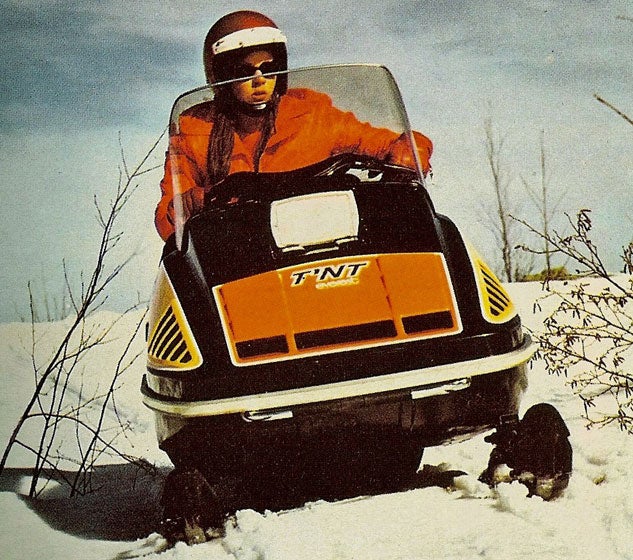 The first “million” Ski-Doo was a 1974 TNT Everest that featured a 5-inch longer chassis, suspension and rubber track than the 440-powered standard TNT.
The first “million” Ski-Doo was a 1974 TNT Everest that featured a 5-inch longer chassis, suspension and rubber track than the 440-powered standard TNT.From 1959 to 1973 the company manufactured its first one million snowmobiles. The next one million took 20 more winters. Now, in 2013, the three millionth Ski-Doo exited the Valcourt production line in late August. All three million Ski-Doo snowmobiles have been assembled in the shadow of J-A Bombardier’s original workshop, which is the key piece of the famed Bombardier Snowmobile Museum in his hometown. While the founding Bombardier family now owns less than 50 percent of the Ski-Doo operation, snowmobile manufacturing remains in Valcourt, just an open door away from thousands of miles of groomed snowmobile trails.
The 1959 Ski-Doo sat low and innovated an industry struggling to sell even small numbers of heavy rear-engined commercial snow vehicles. The Ski-Doo with its front-engined and rubber-tracked configuration proved that people of the 1960s wanted an escape into winter, not away from it! That first decade of production saw incredible growth for the Valcourt-based firm as its light-footed sled proved popular beyond imagination.
By 1973 Ski-Doo enjoyed status as the Number One snowmobile manufacturer, although Arctic Enterprises in Thief River Falls, Minnesota might dispute its claim. The Arctic Cat brand scored substantial sales thanks to its adoption of its own innovation, a parallel rail slide suspension at a time when others relied on bouncy-jouncy bogie wheel support. But it was Ski-Doo that brought its newest model, the 1974 TNT Everest to the one-millionth party held at the 584,000-square-foot Valcourt assembly plant in the late summer of 1973.
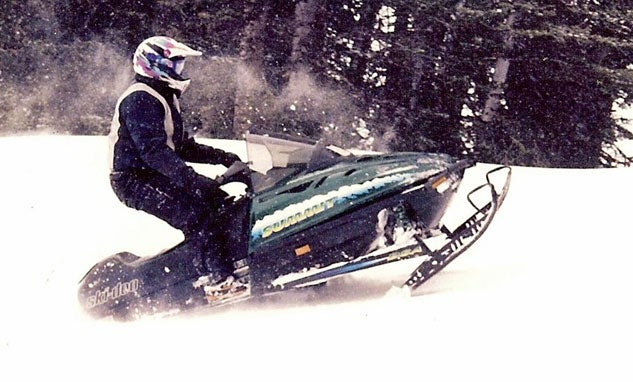 By 1994 Ski-Doo had evolved its product line to satisfy niche markets such as the serious powder riders, who wanted more “snow-ability.” The second “million” Ski-Doo was a 1994 Summit 583 that reflected that aspect with a narrowed front end and stretched 136-inch track length.
By 1994 Ski-Doo had evolved its product line to satisfy niche markets such as the serious powder riders, who wanted more “snow-ability.” The second “million” Ski-Doo was a 1994 Summit 583 that reflected that aspect with a narrowed front end and stretched 136-inch track length.Invitation To Snowmobiling magazine called the 1974 model year Everest “…a big, fast, luxurious machine that will handle like a Porsche and outsnowmobile ninety percent of the 1974s – no matter the terrain.” The Everest differentiated itself from standard TNT models with a five-inch longer track and chassis. To grip snow for climbing and deep powder play, the Everest had been given a wider 16.5-inch track for 907.5 square inches of on-the-snow bite. The top of the line model came with a 436.6cc fan-cooled twin that drove through Ski-Doo’s “square shaft” drive clutch. It weighed in at 465 pounds and stretched 106.75 inches from ski tip to snow flap.
The one-millionth sled appeared to share in the company’s blended sled heritage, as it was sleekly styled in Ski-Doo yellow, black and a hint of Moto-Ski orange. That specific snowmobile was presented to J-Armand Bombardier’s widow, who presented it to the Bombardier Museum where it is on display along with the second millionth sled, a model year 1994 Ski-Doo Summit 583.
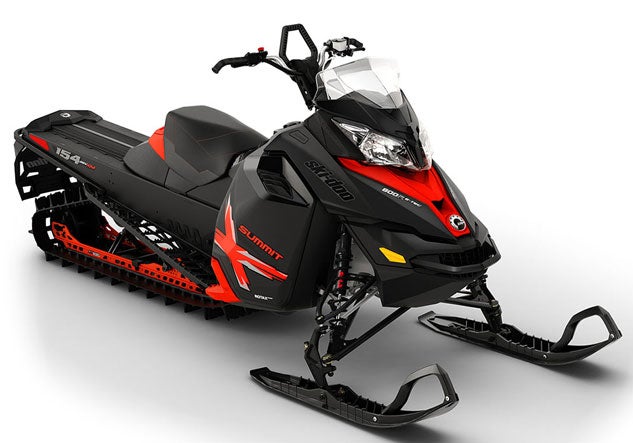 The three “million” Ski-Doo represents the state of the art in 2014 as portrayed by the limited built Summit X with 800 E-Tec two-stroke power.
The three “million” Ski-Doo represents the state of the art in 2014 as portrayed by the limited built Summit X with 800 E-Tec two-stroke power.Keeping it all in the Bombardier family, the founder’s grandson, Pierre Beaudoin, rode it to center stage amid applause that seemed to thunder in the cavernous Valcourt assembly building. Just as the Everest accentuated Ski-Doo’s latest and best efforts in snowmobile manufacturing, the 1994 Summit epitomized much that was new at Ski-Doo.
BRP Celebrates Ski-Doo Number Three Million
The Summit showcased Ski-Doo’s new niche marketing. It had its own color and style to set it apart from the trail performance TNT models and touring segments. Ski-Doo reached outside of its own group by bringing in executives with marketing and packaging expertise from non-snowmobile companies. The idea was to have them help stage Ski-Doo snowmobiles for a broad based attack to stimulate sales. It also created opportunities to bring Ski-Doo product into easily understood segmentation – Ski-Doo yellow sleds like the TNT series aimed at the performance trail rider; Grand Touring offered luxury to serious high mile riders; the Summit sought to get more powder riders. While the Summit featured an instantly recognizable “style,” it also gave powder riders a four-inch narrower front suspension that combined with a longer 136-inch track and rear suspension for improved deep snow-ability.
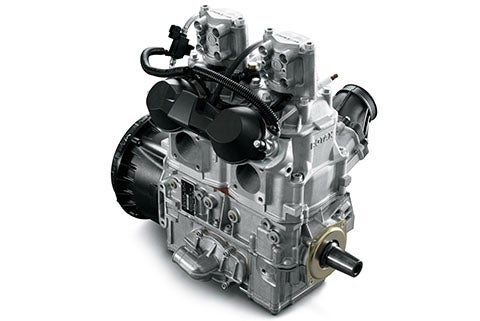 Rotax power has been a consistent constant in each of the “million” Ski-Doo models, starting with a fan-cooled 436.6cc twin up to the 2014 E-Tec powering the top of the line 2014 Summit X.
Rotax power has been a consistent constant in each of the “million” Ski-Doo models, starting with a fan-cooled 436.6cc twin up to the 2014 E-Tec powering the top of the line 2014 Summit X.This sled gave Ski-Doo buyers a new perception of what the Quebec-based sled maker had in store for them. The company followed up the Summit with the manufacture of sleds specifically created to entice buyers in selected niche markets. That continues in today’s snowmobile groupings as Ski-Doo rather uniquely arrived at a high performance off-trail model, the Tundra Xtreme, with strut front suspension and 600cc E-Tec twin. While each niche may not sell huge amounts of snowmobiles, the sales in each niche total up well enough to lead to a three millionth model produced this year.
The most recent “millionth” Ski-Doo is also a Summit, carrying a long-tracked theme that stretches back to the TNT Everest in 1973. The three millionth Ski-Doo to come off the Valcourt production line on August 30th was a model year 2014 Ski-Doo Summit X 800 E-Tec. It was also the first of the “Million” Ski-Doos manufactured under the BRP banner, which does count the Bombardier family as part of its corporate make up.
2014 Ski-Doo Summit X Review – Video
One of the themes that runs through each of the three “million” Ski-Doo snowmobiles produced has been the Rotax power source. The 1974 TNT Everest showcased a Rotax 440cc fan-cooled twin. It was a significant engine for Ski-Doo models, but even then Bombardier’s Rotax engine subsidiary offered more powerful and innovative free-air designs. By the 1994 Summit 583, Rotax power included RAVE valve exhaust and rotary valve intakes for more consistent performance. The current 2014 Summit X features a direct-injected high output version of the Rotax 800cc two-stroke twin that promises greater fuel efficiency and cleaner, “greener” operation. That doesn’t include any of the advances Rotax made in four-stroke engine designs, such as the newest 900cc advanced combustion triple with its three-tiered electronically enhanced performance settings.
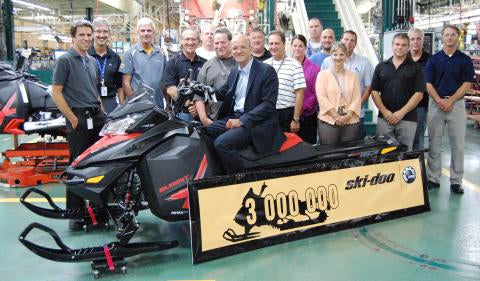 BRP/Ski-Doo president Jose Boisjoli poses this past August on a 2014 Ski-Doo Summit X 800 E-Tec, the three millionth Ski-Doo produced at the Valcourt, Quebec factory.
BRP/Ski-Doo president Jose Boisjoli poses this past August on a 2014 Ski-Doo Summit X 800 E-Tec, the three millionth Ski-Doo produced at the Valcourt, Quebec factory.Each of the three “million” Ski-Doo snowmobiles offers a glimpse into the state of the sport for 1973, 1993 and 2013. Each model can be considered the state of the art for its time. The Everest shows off a slide rail suspension, longer track for smooth ride and improved snow-ability, and a two-stroke fan-cooled drivetrain that was considered somewhat high performance for the mid-1970s. The 1994 Summit 583 highlights Ski-Doo’s niche marketing techniques and provides a look at what was then typical power and suspension considerations for deep snow riders. The latest 2014 Summit X 800R gives us a look at how Rotax responded and solved the “drawbacks” of two-strokes by creating an innovative direct injection system that lets riders maintain the strengths of the two-strokes – lighter weight and rev response – while making them more fuel efficient and “greener.” And, the 2014 “million” Ski-Doo Summit lets us see how far engineering thought and expertise has come in deep powder snowmobiling.
So, while there may be three totally different “Million” Ski-Doo models since J-A Bombardier’s first sled to now, consider that all of these sleds came from the same place, an evolved production and assembly facility located in the hometown where the original was born. Set aside the three million; simply consider what an achievement the Ski-Doo people of Valcourt, Quebec have accomplished. That alone is impressive enough!








 Your Privacy Choices
Your Privacy Choices